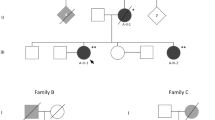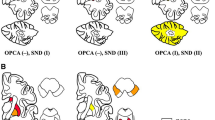Abstract
Following the discovery of glial fibrillary acidic protein (GFAP) mutations as the causative factor of Alexander disease (AxD), new case reports have recently increased, prompting a more detailed comprehension of the clinical features of the three disease subtypes (infantile, juvenile and adult). While the clinical pattern of the infantile form has been substantially confirmed, the late-onset subtypes (i.e., juvenile and adult), once considered rare manifestations of AxD, have displayed a wider clinical spectrum. Our aim was to evaluate the clinical phenotype of the adult and juvenile forms by reviewing the previously reported cases. Data were collected from previously published reports on 112 subjects affected by neuropathologically or genetically proven adult and juvenile Alexander disease. Although the late-onset forms of AxD show a wide clinical variability, a common pattern emerges from comparing previously reported cases, characterized by pseudo-bulbar signs, ataxia, and spasticity, associated with atrophy of the medulla and upper cervical cord on neuroimaging. Late-onset AxD cases can no longer be considered as rare manifestations of the disease. The clinical pattern usually reflects the topographic localization of the lesions, with adult cases displaying a predominant infratentorial localization of the lesions. Juvenile cases show clinical and radiological features which are intermediate between adult and infantile forms.


Similar content being viewed by others
References
Alexander WS (1949) Progressive fibrinoid degeneration of fibrillary astrocytes associated with mental retardation in a hydrocephalic infant. Brain 72:373–381
Balbi P, Seri M, Ceccherini I, Uggetti C, Casale R, Fundarò C, Caroli F, Santoro L (2008) Adult-onset Alexander disease. Report on a family. J Neurol 255:24–30
Brenner M, Johnson AB, Boesflug-Tanguy O, Rodriguez D, Goldman JE, Messing A (2001) Mutations in GFAP, encoding glial fibrillary acidic protein, are associated with Alexander disease. Nat Genet 27:117–120
Brenner M, Goldman JE, Quinlan RA, Messing A (2009) Alexander disease: a genetic disorder of astrocytes. In: Parpura V, Haydon P (eds) Astrocytes in (patho)physiology of the nervous system. Springer, New York, pp 591–648
Brockmann K, Meins M, Taubert A, Trappe R, Grond M, Hanefeld F (2003) A novel GFAP mutation and disseminated white matter lesions: adult Alexander disease? Eur Neurol 50:100–105
Brody BA, Kinney HC, Kloman AS, Gilles FH (1987) Sequence of central nervous system myelination in human infancy. 1. An autopsy study of myelination. J Neuropathol Exp Neurol 46:283–301
Caroli F, Biancheri R, Seri M, Rossi A, Pessagno A, Bugiani M, Corsolini F, Savasta S, Romano S, Antonelli C, Romano A, Pareyson D, Gambero P, Uziel G, Ravazzolo R, Ceccherini I, Filocamo M (2007) GFAP mutations and polymorphisms in 13 unrelated Italian patients affected by Alexander disease. Clin Genet 72:427–433
Crome L (1953) Megalencephaly associated with hyaline pan-neuropathy. Brain 76:215–228
Farina L, Pareyson D, Minati L, Ceccherini I, Chiapparini L, Romano S, Gambaro P, Fancellu R, Savoiardo M (2008) Can MR imaging diagnose adult-onset Alexander disease? AJNR Am J Neuroradiol 29:1190–1196
Friede RL (1964) Alexander’s disease. Arch Neurol 11:414–422
Friedman JH, Ambler M (1992) Progressive Parkinsonism associated with Rosenthal fibers: senile-onset Alexander’s disease? Neurology 42:1733–1735
Garrett R, Ames RP (1974) Alexander disease: case report with electron microscopical studies and review of the literature. Arch Pathol 98:379–385
Gorospe JR, Naidu S, Johnson AB, Puri V, Raymond GV, Jenkins SD, Pedersen RC, Lewis D, Knowles P, Fernandez R, De Vivo D, van der Knaap MS, Messing A, Brenner M, Hoffman EP (2002) Molecular findings in symptomatic and pre-symptomatic Alexander disease patients. Neurology 58:1494–1500
Herndon RM, Rubinstein LJ, Freeman JM, Mathieson G (1970) Light and electron microscope observations on Rosenthal fibers in Alexander’s disease and in multiple sclerosis. J Neuropathol Exp Neurol 29:524–551
Jacob J, Robertson NJ, Hilton DA (2003) The clinicopathological spectrum of Rosenthal fibre encephalopathy and Alexander’s disease: a case report and review of the literature. J Neurol Neurosurg Psychiatry 74:807–810
Kepes JJ, Ziegler DK (1972) Alexander’s disease in an adult (leukodystrophy with Rosenthal fibers). Missouri Med (Suppl) 69:23–25
Kinney HC, Brody BA, Kloman AS, Gilles FH (1988) Sequence of central nervous system myelination in human infancy. 2. Patterns of myelination in autopsied infants. J Neuropathol Exp Neurol 47:217–234
Kinoshita T, Imaizumi T, Miura Y, Fujimoto H, Ayabe M, Shoji H, Okamoto Y, Takashima H, Osame M, Nakagawa M (2003) A case of adult-onset Alexander disease with Arg416Trp human glial fibrillary acidic protein gene mutation. Neurosci Lett 350:169–172
Li R, Johnson AB, Salomons G, Goldman JE, Naidu S, Quinlan R, Cree B, Ruyle SZ, Banwell B, D’Hooghe M, Siebert JR, Rolf CM, Cox H, Reddy A, Gutiérrez-Solana LG, Collins A, Weller RO, Messing A, van der Knaap MS, Brenner M (2005) Glial fibrillary acidic protein mutations in infantile, juvenile, and adult forms of Alexander disease. Ann Neurol 57:310–326
Mastri AR, Sung JH (1973) Diffuse Rosenthal fiber formation in the adult: report of four cases. J Neuropathol Exp Neurol 32:424–436
Messing A, Head M, Galles K, Galbreath EJ, Goldman JE, Brenner M (1998) Fatal encephalopathy with astrocyte inclusions in GFAP transgenic mice. Am J Pathol 152:391–398
Messing A, Brenner M (2003) Alexander disease: GFAP mutations unify young and old. Lancet Neurol 2:75
Mignot C, Boespflug-Tanguy O, Gelot A, Dautigny A, Pham-Dinh D, Rodriguez D (2004) Alexander disease: putative mechanisms of an astrocytic encephalopathy. Cell Mol Life Sci 61:369–385
Namekawa M, Takiyama Y, Aoki Y, Takayashiki N, Sakoe K, Shimazaki H, Taguchi T, Tanaka Y, Nishizawa M, Saito K, Matsubara Y, Nakano I (2002) Identification of GFAP gene mutation in hereditary adult-onset Alexander’s disease. Ann Neurol 52:779–785
Pareyson D, Fancellu R, Mariotti C, Romano S, Salmaggi A, Carella F, Girotti F, Gattellaro G, Carriero MR, Farina L, Ceccherini I, Savoiardo M (2008) Adult-onset Alexander disease: a series of eleven unrelated cases with review of the literature. Brain 131:2321–2331
Peiffer J (1968) Alexander’s disease—really a leukodystrophy? Pathol Eur 3:305–312
Pridmore CL, Baraitser M, Harding B, Boyd SG, Kendall B, Brett EM (1993) Alexander’s disease: clues to diagnosis. J Child Neurol 8:134–144
Riggs JE, Schochet SS, Nelson J (1988) Asymptomatic adult Alexander’s disease: entity or nosological misconception? Neurology 38:152–154
Romano S, Salvetti M, Ceccherini I, De Simone T, Savoiardo M (2007) Brainstem signs with progressing atrophy of medulla oblongata and upper cervical spinal cord. Lancet Neurol 6:562–570
Rosenthal W (1898) Über eine eigentümliche, mit Syringomyelie komplizierte Geshwulst des Rückenmarks. Beitr Pathol Anat 23:111
Russo LS Jr, Aron A, Anderson PJ (1976) Alexander’s disease: a report and a reappraisal. Neurology 26:607–614
Schochet SS, Lampert PW, Earle KM (1968) Alexander’s disease: a case report with electron microscopic observations. Neurology 18:543–549
Seil FJ, Schochet SS, Earle KM (1968) Alexander’s disease in an adult: report of a case. Arch Neurol 19:494–502
Sherwin RM, Berthrong M (1970) Alexander’s disease with sudanophilic leukodystrophy. Arch Pathol 89:321–328
Shiihara T, Sawaishi Y, Adachi M, Kato M, Hayasaka K (2004) Asymptomatic hereditary Alexander’s disease caused by a novel mutation in GFAP. J Neurol Sci 225:125–127
Soffer D, Horoupian DS (1979) Rosenthal fibers formation in the central nervous system: its relation to Alexander’s disease. Acta Neuropathol 47:81–84
Stevenson LD, Vogel FS (1952) A case of macrocephaly associated with feeble-mindedness and encephalopathy with peculiar deposit throughout the brain and spinal cord. Ciencia 12:71–74
Stumpf E, Masson H, Duquette A, Berthelet F, McNabb J, Lortie A, Lesage J, Montplaisir J, Brais B, Cossette P (2003) Adult Alexander disease with autosomal dominant transmission. Arch Neurol 60:1307–1312
Thyagarajan D, Chataway T, Li R, Gai WP, Brenner M (2004) Dominantly-inherited adult-onset leukodystrophy with palatal tremor caused by a mutation in the glial fibrillary acidic protein gene. Mov Disord 19:1244–1248
Tihen WS (1972) Central pontine myelinolysis and Rosenthal fibers of the brainstem: association with emaciation and prolonged intravenous hyperalimentation. Neurology 22:710–716
Ule G (1972) Progressive neurogene Muskelatrophie bei neuroaxonaler Distrophie mit Rosenthalschen Fasern. Acta Neuropathol 21:332–339
van der Knaap MS, Naidu S, Breiter SN, Blaser S, Stroink H, Springer S, Begeer JC, van Coster R, Barth PG, Thomas NH, Valk J, Powers JM (2001) Alexander disease: diagnosis with MR imaging. Am J Neuroradiol 22:541–542
van der Knaap MS, Gajja SS, Li R, Franzoni E, Gutiérrez-Solana LG, Smit LM, Robinson R, Ferrie CD, Cree B, Reddy A, Thomas N, Banwell B, Barkhof F, Jakobs C, Johnson A, Messing A, Brenner M (2005) Unusual variants of Alexander’s disease. Ann Neurol 57:327–338
van der Knaap MS, Ramesh V, Schiffmann R, Blaser S, Kyllerman M, Gholkar A, Ellison DW, van der Voorn JP, van Dooren SJ, Jakobs C, Barkhof F, Salomons GS (2006) Alexander disease. Ventricular garlands and abnormalities of the medulla and spinal cord. Neurology 66:494–498
Vogel FS, Hallervorden J (1962) Leukodystrophy with diffuse Rosenthal fiber formation. Acta Neuropathol 2:126–143
Wilson SP, Al-Sarraj S, Bridges LR (1996) Rosenthal fiber encephalopathy presenting with demyelination and Rosenthal fibers in a solvent abuser: adult Alexander’s disease? Clin Neuropathol 15:13–16
Wohlwill FJ, Bernstein J, Yakovlev PI (1959) Dysmyelinogenic leukodystrophy: report of a case of a new, presumably familial type of leukodystrophy with megalobarencephaly. J Neuropathol Exp Neurol 18:359–383
Conflict of interest
None.
Author information
Authors and Affiliations
Corresponding author
Electronic database information
Accession number and the URL for data in this article are as follows: Online Mendelian Inheritance in Man (OMIM), http://www.ncbi.nlm.gov/Omim (for Alexander disease [MIM 203450] and GFAP [MIM 137780]). Alexander disease on Waisman Centre, University of Wisconsin-Madison, USA, http://www.waisman.wisc.edu/alexander/index.html. ‘Human Intermediate Filament Database’ of the Centre for Molecular Medicine and the Bioinformatics Institute in Singapore, http://www.interfil.org/details.php?id=NM_002055. ‘GeneTests Web site’ hosted by National Center for Biotechnology Information at http://www.ncbi.nlm.nih.gov/sites/GeneTests.
Electronic supplementary material
Below is the link to the electronic supplementary material.
Rights and permissions
About this article
Cite this article
Balbi, P., Salvini, S., Fundarò, C. et al. The clinical spectrum of late-onset Alexander disease: a systematic literature review. J Neurol 257, 1955–1962 (2010). https://doi.org/10.1007/s00415-010-5706-1
Received:
Accepted:
Published:
Issue Date:
DOI: https://doi.org/10.1007/s00415-010-5706-1




